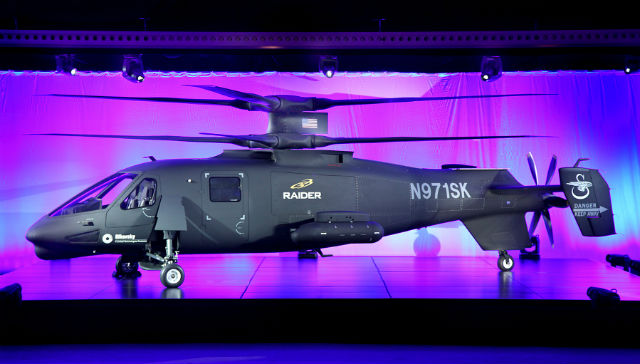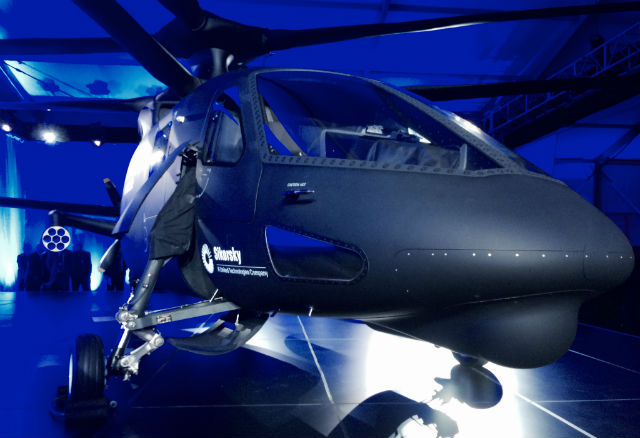Sikorsky has completed the prototype for a revolutionary rotorcraft design that could dramatically improve the speed and hover capabilities of the traditional helicopter.
After four years of internal research and development, the company on 2 October revealed the S-97 Raider, which combines dual coaxial rotor blades and a tail propeller to combine the hover capability of a helicopter with the speed of a fixed-wing aircraft.
“The rollout of a new helicopter is rare," says Sikorsky vice-president of technology and innovation research and engineering Chris Van Buiten, speaking at the company's West Palm Beach site in Florida. "The rollout of a new configuration is rarer still."

Sikorsky
Raider has dual coaxial rotors for vertical lift and a tail propeller for forward thrust. The combination allows for flight characteristics that are physically impossible for existing rotorcraft designs.
It was designed to carry more than 4,990kg (11,000lb), or six troops plus crew. With external weapons mounted, Sikorsky says it will fly at least 220kt (407km/h). Unarmed it will fly at up to perhaps 270kt, but S-97 chief engineer Andy Bernhard will not specify how fast they intend to fly it during testing.
Raider was announced, designed and built in four years based on the company's experiences with the X2 concept demonstrator. Raider brings that aircraft's technology into a practical aircraft that can demonstrate real-world mission capabilities, says Bernhard.
Sikorsky invested $150 million for the development effort – around 70% of the total cost to produce the prototype S-92. Its 54 suppliers provided the remaining capital.
"With X2 everyone was wondering what it was, what it was supposed to do," Bernhard says. "With Raider, potential customers see it and they're talking about the size of the doors and things like that. They are already thinking up new mission sets. They get it."

Dan Parsons/Flightglobal
Van Buiten says the aircraft can achieve 50-100% improvements in six flight characteristic measurements including speed, agility and manoeuvrability.
For one, it will be able to refuel at 200kt: much faster than current helicopters that require aerial tankers to reduce altitude and slow dramatically to transfer fuel.
Raider was initially pitched as a candidate for the US Army's armed aerial scout (AAS) programme to find a replacement for ageing Bell Helicopter OH-58D, which cruises at around 90kt.
AAS has been put on hold for fiscal reasons, but Sikorsky believes Raider could satisfy requirements like future vertical lift (FVL); the army's unofficial plan to replace all of its rotorcraft, beginning with the Sikorsky UH-60 Black Hawk.
"While armed aerial scout may be on hold for now, our commitment to the US Army is not," says Mick Maurer, president of Sikorsky. The Raider positions the company well to pursue FVL, "which is shaping up to be a winner-take-all programme," he says.
As congratulatory as Sikorsky executives were at the rollout ceremony, challenges remain for Raider, which has not yet flown. The company hopes to complete ground runs in time for first flight by the end of the year.
The aircraft's software and avionics suite have been finalised and are in verification testing. Bird-strike testing at 229kt has also been successfully completed.
A transmission testbed with rotors, engine and rotorshaft has been built. It needs only a second gearbox before testing can begin on the drive system, says Mark Hammond, Raider programme manager.
"It's kind of a drag race between the testbed and the aircraft," he says. "We finished the aircraft first because it has a much longer lead times, but they'll both get going about the same time."
Raider is in component testing in anticipation of ground testing that must be completed before first flight.
Source: FlightGlobal.com



















